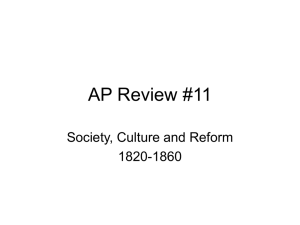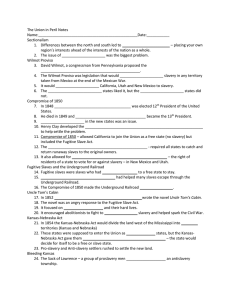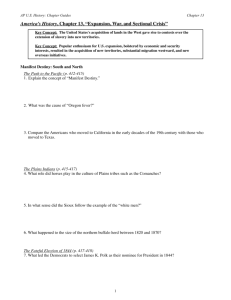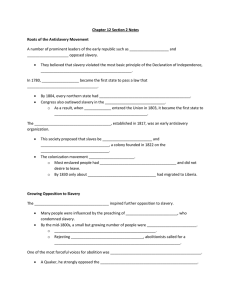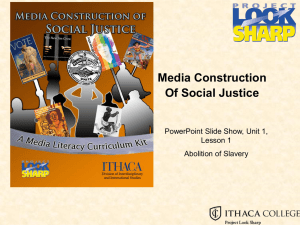Objectives
advertisement
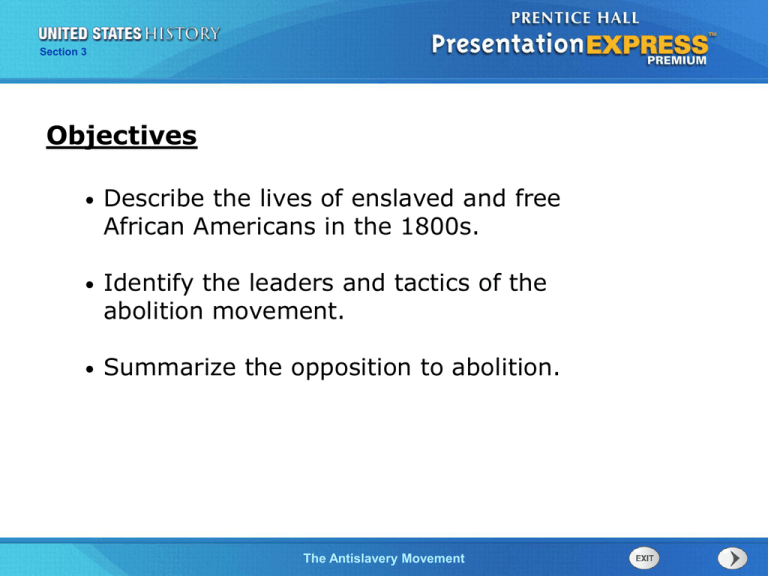
Section 3 Objectives • Describe the lives of enslaved and free African Americans in the 1800s. • Identify the leaders and tactics of the abolition movement. • Summarize the opposition to abolition. The Cold The War Antislavery Begins Movement Section 3 Terms and People • freedman – a former or freed slave • Nat Turner – led a Virginia slave revolt in 1831 that killed nearly 60 people before he and his followers were caught and executed • abolition movement – reform movement for the abolition or end of slavery • William Lloyd Garrison – editor of the abolitionist newspaper The Liberator The Cold The War Antislavery Begins Movement Section 3 Terms and People (continued) • Frederick Douglass – escaped slave who spoke passionately about his experiences, also published in his autobiography Narratives of the Life of Frederick Douglass • Gag Rule – 1836 law that prohibited the debate or discussion of slavery in Congress The Cold The War Antislavery Begins Movement Section 3 How did reformers try to help enslaved people? In the early and mid-1880s, reformers tried to improve life through campaigns to help children, families, and disadvantaged adults. Soon, some reformers also set out to help enslaved African Americans. The Cold The War Antislavery Begins Movement Section 3 As the South’s cotton-based economy grew, so did its reliance on slavery. • By 1830, there were 2 million African American slaves in the South. • One in three slaves was under the age of ten. • Most did back-breaking labor: cultivating cotton fields, loading freight, or working in hot kitchens. The Cold The War Antislavery Begins Movement Section 3 • • Brutal overseers enforced work routines with whipping, beating, maiming, and humiliation. • Often, the basics for survival, including clothing, food, and shelter, were barely provided. Family members were often separated, and slaves could not be taught to read or write. The Cold The War Antislavery Begins Movement Section 3 Most slaves found ways to maintain their hope and dignity. • Many relied on their religious faith, based on a mix of traditional African and Christian beliefs. • Others resisted their bondage by breaking tools or outwitting overseers. • Thousands escaped to the North or to Mexico using a network of paths and safe houses called the Underground Railroad. The Cold The War Antislavery Begins Movement Section 3 Some slaves fought back. Over 200 slave revolts occurred in the first half of the 1800s. • In 1822, freedman Denmark Vesey plotted a huge uprising near Charleston. He and dozens of accomplices were captured and hanged. • In 1831, slave Nat Turner and his coconspirators killed 60 whites near Richmond, Virginia. Turner, who acted on what he believed was a sign from God, was executed. Undeterred, slaves still resisted their captivity. Many people in the North joined their cause. The Cold The War Antislavery Begins Movement Section 3 By the early 1800s, there was a growing antislavery or abolition movement in the North. By 1804, all states north of Maryland outlawed slavery. The Cold The War Antislavery Begins Movement In 1807, the importation of new slaves was outlawed. Section 3 As Northern states began to abolish slavery, the number of freed slaves, or freedmen, grew. • In 1816, the American Colonization Society (ACS) was formed to encourage slaves to return to Africa. • The ACS established the colony of Liberia in Africa. By 1830, more than 1,100 freedmen had relocated. • Many freedmen distrusted the ACS, fearing that colonization was a plan to exile able black leaders. The Cold The War Antislavery Begins Movement Section 3 Religious individuals fostered the growth of the abolition movement. Pamphleteer, David Walker, a free African American, called slavery incompatible with the Second Great Awakening’s religious teachings. Baltimore Quaker, Benjamin Lundy, printed the first antislavery newspaper. William Lloyd Garrison, a leader of the abolitionist movement, began his own newspaper in 1831—The Liberator. The Cold The War Antislavery Begins Movement Section 3 Garrison used dramatic arguments called “moral suasion” to advocate for immediate freedom and full political and social rights for African Americans. By 1840, over 150,000 belonged to abolition groups, such as the American Anti-Slavery Society. The Cold The War Antislavery Begins Movement Section 3 In 1845, Frederick Douglass, an escaped slave, published his autobiography Narratives of the Life of Frederick Douglass. An eloquent and stirring speaker, he later became an advisor to Abraham Lincoln during the Civil War. The Cold The War Antislavery Begins Movement Section 3 Southerners defended slavery from abolitionist attacks. • They maintained that northern textile mills also depended on southern cotton. • They claimed that slaves were treated better than northern factory workers. • They declared that slavery was supported by the Bible. The Cold The War Antislavery Begins Movement Section 3 As abolitionist rhetoric grew more strident, Southern support for manumission decreased. • Anti-abolitionist leaders pressed harder in their defense of slavery in the South. • Post offices refused to deliver abolitionist newspapers. Even Southerners who did not own slaves saw slavery as vital to their way of life. The Cold The War Antislavery Begins Movement Section 3 Most northerners were also opposed to abolition. • White workers feared that freedmen were going to take their jobs. • Northern businessmen resented black competitors. • Factory owners worried about the loss of Southern cotton for their mills. The Cold The War Antislavery Begins Movement Section 3 Most in the North disliked southerners, but did not care to fight over slavery. Politicians from both regions passed the Gag Rule in 1836. It prohibited debate or discussion on slavery in Congress. Abolition and slavery continued to drive a wedge between the increasingly industrialized and urban North and the rural agricultural South. The Cold The War Antislavery Begins Movement
